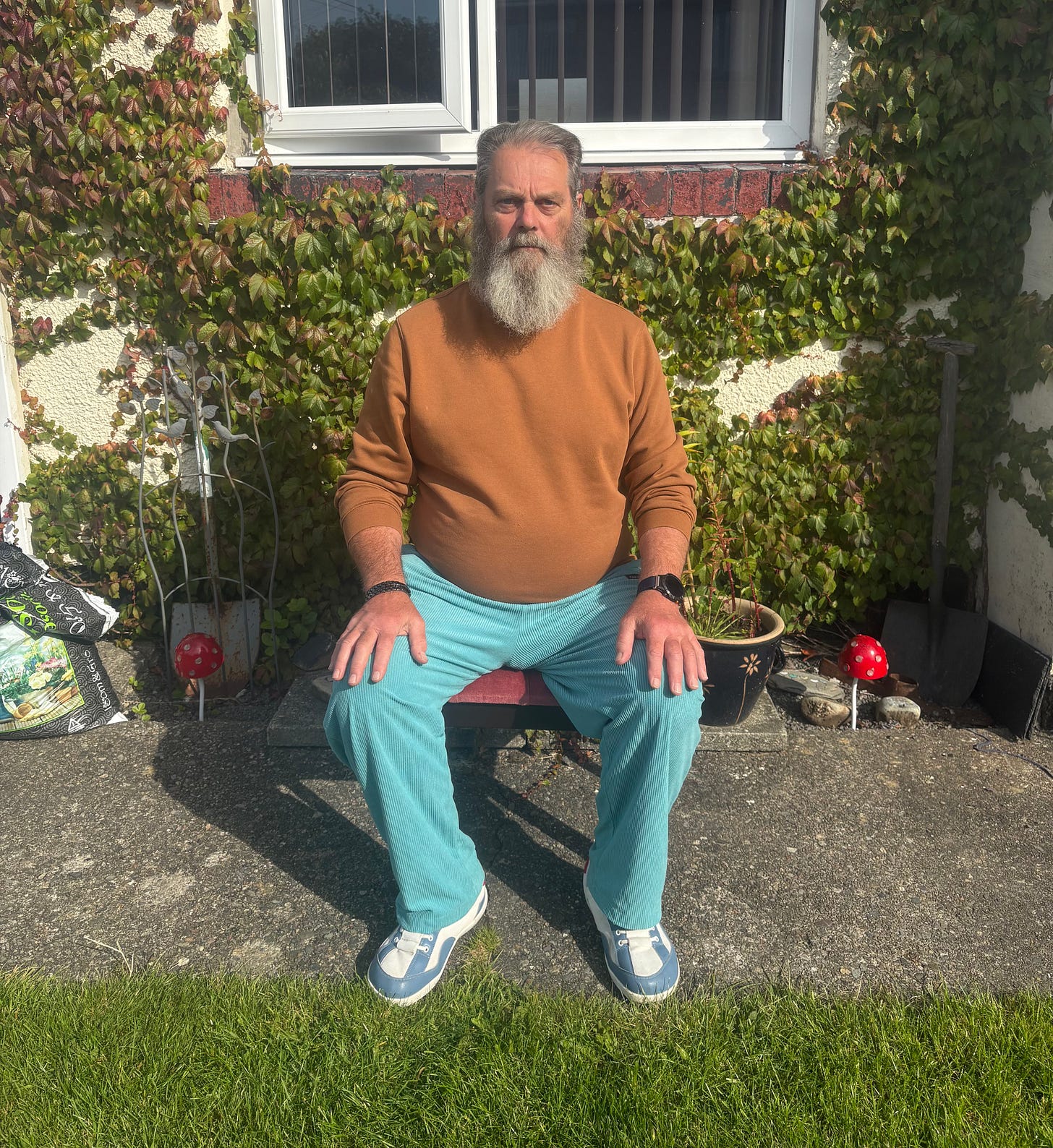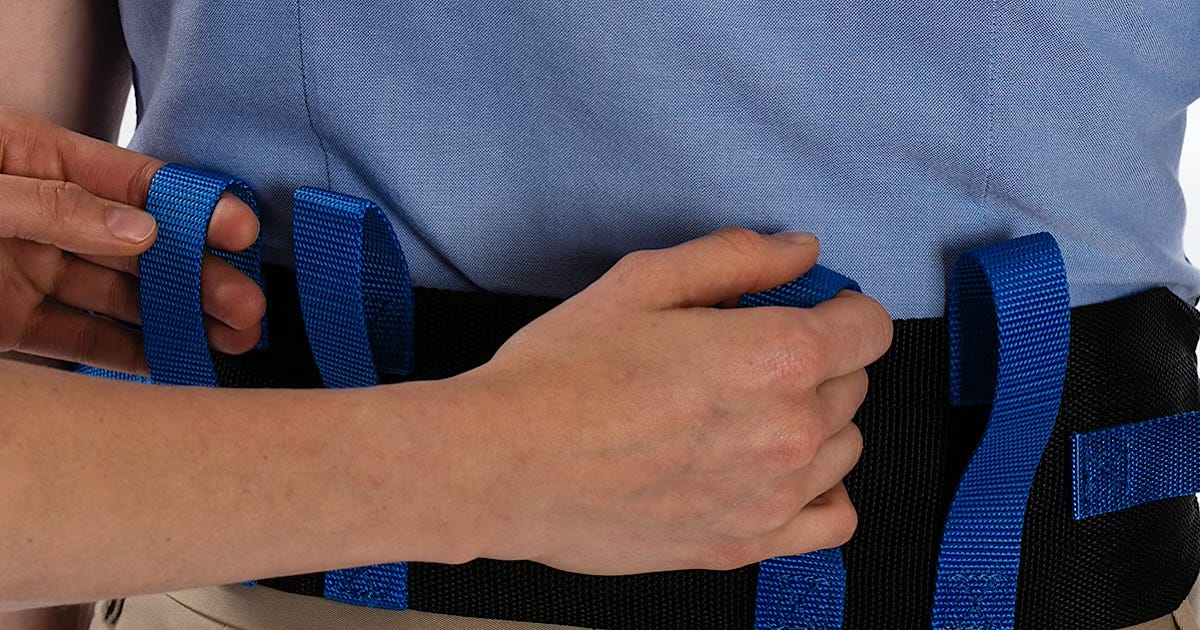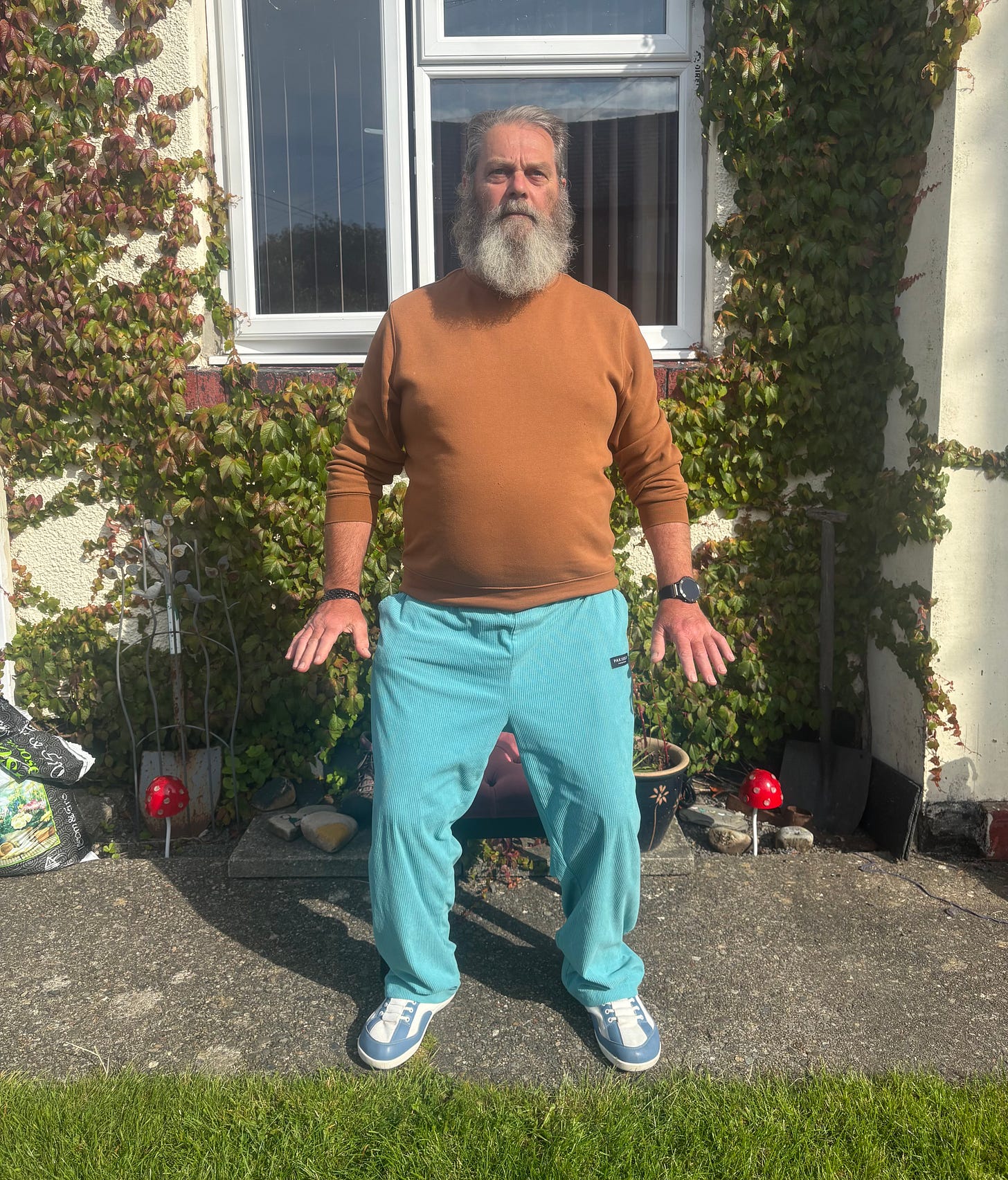Standing with Hands on the Heads of Two Tigers
A Safe Adaptation for Stroke Recovery
I remember the first few days, lying in the hospital bed, wondering where all my power had gone. I got wheeled off down to the Physio department where I was assessed and put through my paces. It was exhausting. Three steps and not to put too fine a point on it, I was fucked. Then they had me lying in the floor and trying to push my torso up. Wobbling and struggling. The screaming in my head. Of course I’m too polite to give full vent. I went along with everything, basically because I was so embarrassed.
The old public school upbringing of stuff upper lip came in.
I was bloody getting out of there. I didn’t want to be seen like that. I just wanted, desperately, to go home. Just like when I was 8 years old. At night I cried into my pillow, muffling the sounds, just as then. In truth I was as weak as a baby, physically and mentally. When I got home I just collapsed into my self for about a week. Eventually, I came to. The stark light of my reality smacked me in the face. There was only one person that could help me now: Me.
I had done Yoga for years when climbing, so I started with that. It took less than a minute to realise that I had bitten off more than I could chew. It was just too demanding and it really bloody hurt! I started to research, read and study.
Just before I went into hospital I had taken up the advice of a friend and had begun to look into Tai Chi. I already had a couple of apps on my iPad that I had been playing with. Still a bit too hard; standing on one leg and leaping around gracefully wasn’t going to happen. Later maybe, but not yet. Still, I was heading in the right direction. I looked a bit deeper and began to learn about Qigong and its therapeutic value. This is where I really started to learn about doing nothing. Do without doing and all things get done. I will tell you about my spiritual journey, some other time. Let’s keep on topic.
I could do this. So I began.
Here is a rather more in depth working of the steps that I took. I’ve worked it into a short instructional guide that anyone can follow
This adapted Qigong posture is absolutely great for the beginnings of post stroke recovery
Or, indeed, for anyone who has become so debilitated that anything is a struggle.
The greatest battle that you have to fight is the one in your head. That’s where you are damaged, so that’s where you must begin.
Indulge me and imagine, for a moment if you will, that there are Two Wild Tigers standing by your sides. Your aim is to subdue and tame them. You won’t do it by grabbing them by the ears, you must rest your hands gently on the tops of their heads and by relaxing so harness their power. If that all sounds a bit hippy dippy then trust me it’s not.
Your mind is In turmoil, it’s experienced a deep trauma. Your psyche is wounded. You are weak. You are vulnerable. The Tigers are the facets of your brain. The Left and the Right. In Traditional Chinese Medicine this is the initial theory of Yin and Yang. The Dark and the Light. The Hard and the Soft.
It has been the popular myth in western thinking that the two halves of the brain are distinct and different. In Eastern thought this is not so. Whilst the Brain functionally has differences between its left and right hemispheres, it operates as one. There is light in the darkness and darkness in the light. This then is where you must begin, for without that oneness you are lost in the wilderness.
The following exercises are physically simple and will help you to begin to explore your limitations and develop or redevelop your proprioceptive skills. Mentally? That’s another story. Cast your mind back to your first hill, your first climb, your first paddle. Where was the battle then ?
Introduction
The "Standing with Hands on the Heads of Two Tigers" (双手按虎头, Shuāng Shǒu Àn Hǔ Tóu) is a powerful qigong and martial arts posture that builds strength, balance, and mental focus. While not a standard therapeutic exercise, its adaptations can benefit stroke survivors by gently restoring mobility, proprioception, and confidence.
This guide covers:
Step-by-Step Modifications (seated, supported, and progressive).
Photographs for visual learners.
Breathing Techniques to enhance recovery.
Cautions to ensure safety.
————————
1. Adapted Techniques for Stroke Survivors
A. Seated "Two Tigers" (Chair Version)
For: Limited mobility or balance concerns.
How to Do It:
Sit upright in a chair, feet flat.
Place palms on thighs or a table.
Inhale deeply, then exhale while pressing down gently (5–10% strength). Hold that image of the Tigers beneath your hands. Don’t force the issue.
Hold for 5 seconds, release. Repeat 7x.
Benefits:
Safe for unilateral weakness (use one hand if needed).
Activates core and shoulder stabilizers.
You could do this several times a day in reps of 7 for a week if you like. Then when you feel ready move on.
If you are in the very early days of your stroke recovery you are going to tire very quickly. The key part of this exercise is not In the contraction or engagement of your muscles but in the relaxation of them. If it helps try sighing as you exhale. Feel like you are melting back down.
————————
B. Standing with a Gait Belt
This one is to be done with assistance. It gives you the illusion of free standing but with the support you need without artificial aids like sticks or walkers
For: Rebuilding standing endurance.
How to Do It:
Start sitting on a stool or somewhere your caregiver can support you from behind. Shuffle to the front. Begin to rise. Use your hands on your thighs for extra oomph and support. This is going to be bloody hard at first. Counterintuitively you need to relax. Remember how it was before you had your stroke, how effortless it was to get up out of a chair and stand. You might have to remember a while back before your stroke. Strokes don’t happen like a bolt of lightning they come on gradually over time.
Stand normally for as long as it takes for you to gain your composure. Your butt is going to want to sit down again. Resist.
Gradually and gently soften the knees. Don’t look at the floor. Choose a point at about eye-level and look at that. Beginning with the eyes begin to relax all the way down your body. Imagine you are being supported by a thread from the middle of your head and you are just hanging there. Let your shoulders soften downwards and let your arms hang at your side. Until you are standing effortlessly. All the while your caregiver is gently holding your belt, giving you support you need. Not too much and not too little
This is likely to wear you out quite quickly.
Hold 10–30 seconds.
At any time if it gets too much. Sit down. Pause. Regain your composure and do it again. Aim for 3 rises and stands at first. Then move on to 7, then several times a day. It’s a big goal I know. The aim is to get you standing with a firm foundation. Everything you do after will become easier.
————————
C. Advanced: Unsupported Stance (When Ready)
Resist the urge to go straight to this. It just makes relaxing into it harder. The idea is to reduce tension not increase it. If you find that you need to stay at the sitting or assisted phases that’s great. In my next post I will be making some suggestions for seated exercises based on Qigong to help speed up your recovery.
For: Higher-level recovery.
The key to this is to relax. The more it feels like you are doing nothing at all, the better it’s working. Counterintuitive, isn’t it?
How to Do It:
Again. Begin in the seated position. At first you might want to continue to wear your gait belt and have some support as you rise. This is fine and actually a really good idea. The last thing you want to do is end up on the floor.
Time to take the training wheels off. Allow your caregiver to let go. (Note to caregiver, especially if it’s your significant other - you can do this )
Stand without aids, feet about shoulder width. Feet facing forward. Again, imagine you are being suspended by a thread and let your weight fall onto your feet. Examine and explore how your hips, knees and ankles are doing. Try to spread the feet so that they are supporting you evenly. This too is going to be hard, bloody hard
Soften the Knees, press palms forward/downward.
Imagine holding two tigers back.
Start with 7-second holds. Just breathe normally. Then relax your arms and allow the legs to straighten. Avoid locking the knees back. Repeat. Once you have the hang of it begin to introduce the breathing. Become like a pump. Just keep it going, enter into that familiar flow state. Keep it gentle and don’t overexcite the nervous system by trying to force things.
Here’s a quick note on Soft Knees
In Qigong, "soft knees" refers to a subtle bend in the knees, maintaining a relaxed and flexible state rather than locking them straight. This principle is crucial for proper posture, balance, and efficient energy flow within the body, particularly during weight-bearing movements.
Here's why soft knees are important in Qigong:
Improved Circulation and Energy Flow:
Locking the knees restricts blood and energy flow, whereas soft knees allow for a more fluid and natural circulation of Qi (vital energy).
Enhanced Stability and Balance:
Soft knees act as shock absorbers, distributing weight evenly and reducing strain on the joints, particularly the knees, ankles, and lower back.
Proper Body Alignment:
By keeping the knees slightly bent, it becomes easier to maintain a neutral pelvis and avoid excessive arching or rounding of the lower back.
Increased Flexibility and Range of Motion:
Soft knees allow for greater flexibility in the legs and hips, facilitating smoother, more natural movements.
Reduced Risk of Injury:
Locking the knees can lead to increased stress on the knee joint, potentially causing pain or injury. Soft knees help protect the joints by absorbing impact and promoting even weight distribution.
Facilitates Spinal Movement:
Soft knees are essential for allowing the spine to twist naturally, which is important in many Qigong and Tai Chi forms.
In practice, soft knees mean:
Avoiding hyperextension (locking the knees).
Bending the knees slightly, creating a feeling of "sitting in the hips".
Ensuring the knees do not extend beyond the toes when bending.
Maintaining a feeling of lightness and relaxation in the legs.
By cultivating soft knees, practitioners can enhance their Qigong practice, promoting both physical and energetic well-being
————————
2. Breathing Protocol for Recovery
Pair with movements for better oxygenation and nerve activation:
Inhale (4 sec): Through the nose, expanding the abdomen.
Pause (2 sec): Hold gently.
Exhale (6 sec): Through pursed lips, engaging core.
Why It Helps:
Slows heart rate, reducing stress.
Improves diaphragmatic function (often weakened post-stroke).
————————
3. Key Benefits for Stroke Survivors
✔ Leg/Core Strength: Builds stability for daily tasks.
✔ Neuroplasticity: Mindful movement rewires the brain.
✔ Confidence: Gradual progression restores independence.
✔ Circulation: Gentle pressure boosts blood flow.
————————
4. Critical Cautions
⚠ Avoid if:
Shoulder subluxation is present (use a sling for support).
Blood pressure is unstable (skip forceful exhales).
Spasticity triggers (modify hand position). More on this and the dreaded Drop Foot in another post.
⚠ Always:
Use a gait belt if standing unsupported. (A gait belt, also known as a transfer belt, is a safety device used to assist individuals with mobility limitations during transfers and ambulation. It is a fabric or vinyl belt placed around the patient's waist, providing a secure point for caregivers to hold and support the patient. This helps prevent falls, aids in safe movement between surfaces, and offers stability during walking)
Suggestion - Work with a physical therapist to tailor the exercise.
————————
5. Progression Plan
Stage
Duration
Support Level
Seated
1–2 weeks
Chair/table
Standing (Aided)
2–4 weeks
Walker/wall
Standing (Unsupported)
4+ weeks
None (as tolerated)
————————
There’s a lot going on here
So, there you have it. Simple isn’t it? If you find it all too easy, great, if you find it hard, also great. Want to make it harder? Just stand longer. See if you can increase the standing time to minutes not seconds. Work harder on your posture. Keep imagining that thread running from the middle of the top of your head up into the sky holding you up. Keep breathing with intent. If your knees begin to hurt, then stop. You’re trying to build strength not endure pain. That comes later…
So, listen. Everybody’s stroke is different. The scope and severity of your debilitation will vary. Here’s the thing - if you have in your mind the ability to conceive that you might improve you will. It might even take time to get to that comprehension.
Every single thing that you do, mental or physical that moves you forward is a victory. Battles are won by inches not miles. As they say in Wales - Pob Luc. Good Luck and see you on the hill…
If you have any comments, questions or even tips - I’m always willing to learn - then comment below. If I’m not out paddling I will get back to you sharpish
#qigong #stroke_rehab #tigerstyle #theunfinishedblock





